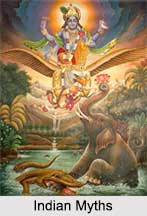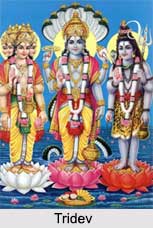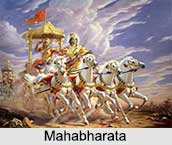 Indian Myths are colourful parts that form the beautiful assortment of people"s cosmology, which in itself is the totality of the world they live, according to the Mythologists. People generally have doubts concerning myths. Only the historians can give us a genuine answer regarding the myths, whether it can be believed or not. Every aspect of religion, including the rites, ceremonies, sermons, prayers, sayings and actions of the people"s daily life is based and dependent on mythology. Religion is a part of mythology. Mythology tells us what people believe, as every religion is in itself based on beliefs or truths. The truths in religion cannot be proved nor disproved.
Indian Myths are colourful parts that form the beautiful assortment of people"s cosmology, which in itself is the totality of the world they live, according to the Mythologists. People generally have doubts concerning myths. Only the historians can give us a genuine answer regarding the myths, whether it can be believed or not. Every aspect of religion, including the rites, ceremonies, sermons, prayers, sayings and actions of the people"s daily life is based and dependent on mythology. Religion is a part of mythology. Mythology tells us what people believe, as every religion is in itself based on beliefs or truths. The truths in religion cannot be proved nor disproved.
History of India
India"s history when summarized is a list of dynasties with numerous emperors who ruled at different times at different capitals. Each dynasty is renowned for its distinctive art, architecture, sculptures and paintings. In India there are places, which are noted as being the spots of seven most ancient capital cities of India.
 Hastinapur on the River Ganges is now a small village but during the Epic times, was the capital of a kingdom. Indraprastha was believed to be underneath the present New Delhi. Ujjain in the Vindhya district still has ample ruins. Kapilavastu, which is in the North, was once the kingdom of Buddha"s father. Ayodhya, near Oudh was once Rama"s capital. Kosala was the capital of the extensive kingdom of Shravasti, who was the founder of Shishunaga dynasty. Until Alexander the Great arrived, the Indus remained as the border between India and Persia. Ajatashatru succeeded his father Bimbisara during the 494-467 BC. He built the fortress of Patali, which was later developed into the majestic city of Pataliputra. Later he conquered the kingdom of Kosala.
Hastinapur on the River Ganges is now a small village but during the Epic times, was the capital of a kingdom. Indraprastha was believed to be underneath the present New Delhi. Ujjain in the Vindhya district still has ample ruins. Kapilavastu, which is in the North, was once the kingdom of Buddha"s father. Ayodhya, near Oudh was once Rama"s capital. Kosala was the capital of the extensive kingdom of Shravasti, who was the founder of Shishunaga dynasty. Until Alexander the Great arrived, the Indus remained as the border between India and Persia. Ajatashatru succeeded his father Bimbisara during the 494-467 BC. He built the fortress of Patali, which was later developed into the majestic city of Pataliputra. Later he conquered the kingdom of Kosala.
The Indian People
It is generally believed that in 1500 BC all the people of India were living together peacefully and the merciless Aryans who invaded the country from the North destroyed this peace. Many other races too invaded India, one after the other. According to the historians, the Dravidians once inhabited the major part of North- West India before the Aryans dislodged them. The Tibeto-Burmese people migrated from North China to occupy their present habitat. The scattered groups of people who are collectively called as Austro-Asiatic and the Andamanians preceded them.
Literature on Indian Myths
Vedic literature dates back to 1500 BC. It is the oldest Asian literature of a tradition. The Vedic hymns are still studied by the Brahmins. It is believed that the Sanskrit literature originated in 1200BC. The most renowned works of the post-Vedic period are the "Upanishads" and the "Puranas".  The most voluminous single work is the great epic "Mahabharata". It is considered as the fountain of Indian mythology. Another great work during this period is the "Ramayana", which portrays the story of Rama, Sita and Hanuman. The famous prose collection of fables is the "Pancha Tantra", "Hitopadesha", "Shuka-Saptati" and many more. In Pali literature, there was great interest in "Jataka Tales".
The most voluminous single work is the great epic "Mahabharata". It is considered as the fountain of Indian mythology. Another great work during this period is the "Ramayana", which portrays the story of Rama, Sita and Hanuman. The famous prose collection of fables is the "Pancha Tantra", "Hitopadesha", "Shuka-Saptati" and many more. In Pali literature, there was great interest in "Jataka Tales".
Sources of Indian Myths
The single great source for Indian mythology is "Mahabharata", which is a vast storehouse of Indian culture, manners and morals. This great epic took more than a thousand year to be composed. Mahabharata is considered as one of the greatest epics in the world literature not only because of its venerable antiquity or its enormous size but also because of the fact that entire life of India in Antiquity is in it and also there is the presence of nobility and humaneness. It also explains in detail religion and its sacrifices, liturgies, priests and ascetics. The forests, rivers and mountains of India are vividly described.
The Mahabharata is a textbook of ethics full of prominent moral lesson in them. It depicts the different emotions inherent in human beings as love, hatred, jealousy, revenge, forgiveness, faithfulness, treachery and a hundred other emotions as well.




















